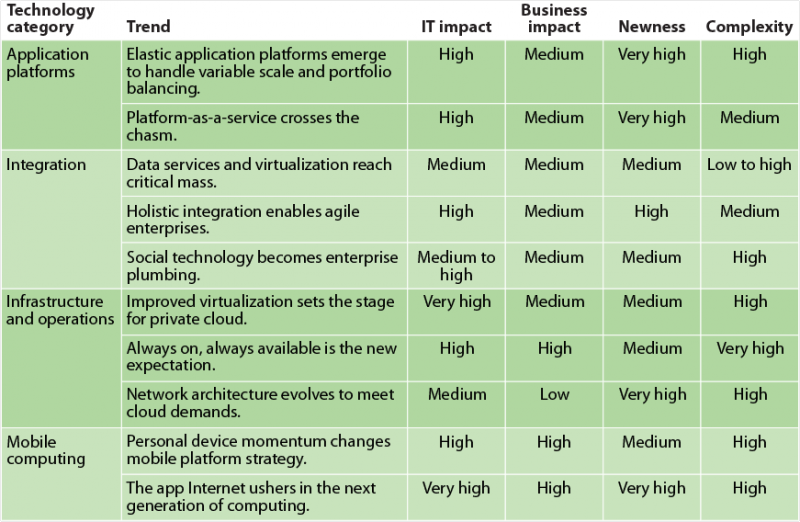The Top Technology Trends For The Next Three Years: Part Two

As promised in my blog last week, here is part 2. In part 1, I introduced the two trends reports we did this year and showed the list of trends for business technology. These are trends and technologies to consider first with your "business hat" on. This blog post lists the other 10 trends to view first from a technology lens because they are of lower interest or impact to the business.
We have created four new categories to make IT stakeholder identification easier: 1) application platforms will be of high interest to your app dev and management teams; 2) integration will be of interest to app dev, data integration specialists, and even process folks (considering that processes can and should be integrated with apps and data); 3) infrastructure and operations; and 4) mobile computing, which spans infrastructure, app dev, and possibly line-of-business relationship managers who are very keen on mobility. And don't forget your security and compliance stakeholders, who will generally care about all of these!
Before listing the trends and technologies, I also want to introduce a new twist to our research this year - we have identified four major themes that run through many of our business technology and technology trends. These themes are so broad and far reaching that we thought it worth calling them out separately; we are advising our clients to understand these themes as the context for responding to individual trends:
- Empowered. Forrester has been writing extensively about the empowerment trend for a few years now; however, we see further acceleration around this theme. Did you know that in 10 years, more than 50% of the workforce will be Millennials who grew up with thumbs on mobile keyboards? These workers are likely to furnish themselves with technology outside of IT's control, and it's likely to be much better. We think firms that learn how to manage and take advantage of mobile, social, collaboration, and self-service technology will have a big advantage. This idea influences a lot of our trends.
- XaaS. The term "everything-as-a-service" is still a subject of debate here at Forrester. What's not up for debate is the impact that service-enabling disruptions such as cloud, in all its forms, are having. They fundamentally shift IT service acquisition and consumption models. Innovative firms are finding ways to take advantage of cloud capabilities to save a bundle and even create new revenue streams. That said, cloud is not always cheaper, and many of our trends address the nuances of various cloud services and what you need to consider in shaping your strategy.
- App Internet. Did you know that an iPad 2 would have been one of the most powerful supercomputers in the word in 1985? Now we take them everywhere. This represents a fundamental shift of computing power out of the data center and to the "edges" where people are and business happens. The cloud itself is not the only answer - the app internet is a fundamentally new architecture that leverages cloud-tethered, context-aware mobile devices that interact with each other and our enterprises. This theme also reflects the idea that the application user experience is shifting away from the monolithic to small, tailored, and integrated bits of functionality that we can get as needed and for whatever device we have.
- Big data. I've written a lot in this blog on the subject, so I won't write much more here. The theme concerns how leading firms are doing more, with more data, more cheaply. Check out Big Data Help Will Shape Your Market's Next Big Winners.
Without further adieu, here are this year's technology trends (can you see how the four themes wind through them?):
